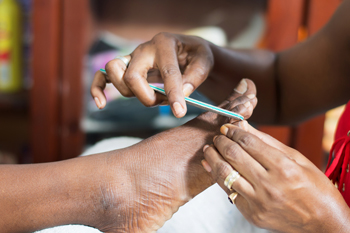 If you notice a small thickened area in the heel or bottom of your foot producing severe pain and discomfort, you may have what is referred to as a verruca wart, which is more commonly known as a plantar wart. It is caused by the human papillomavirus (HPV), and will typically attack the skin on the bottom of the feet. It typically lives and thrives in moist and warm environments which may include public pools and surrounding areas, shower room floors and locker rooms. It is known to enter the body through tiny cracks in the skin and grows into the heel as a result of pressure the foot endures while walking. Many people may notice a small and callused area where the wart has formed, and small black dots may be present in the center. If you have developed a plantar wart, please speak to a podiatrist who can properly treat this condition.
If you notice a small thickened area in the heel or bottom of your foot producing severe pain and discomfort, you may have what is referred to as a verruca wart, which is more commonly known as a plantar wart. It is caused by the human papillomavirus (HPV), and will typically attack the skin on the bottom of the feet. It typically lives and thrives in moist and warm environments which may include public pools and surrounding areas, shower room floors and locker rooms. It is known to enter the body through tiny cracks in the skin and grows into the heel as a result of pressure the foot endures while walking. Many people may notice a small and callused area where the wart has formed, and small black dots may be present in the center. If you have developed a plantar wart, please speak to a podiatrist who can properly treat this condition.
Plantar warts can be very uncomfortable. If you need your feet checked, contact one of our podiatrists from San Antonio New Step. Our doctors will assist you with all of your foot and ankle needs.
About Plantar Warts
Plantar warts are the result of HPV, or human papillomavirus, getting into open wounds on the feet. They are mostly found on the heels or balls of the feet.
While plantar warts are generally harmless, those experiencing excessive pain or those suffering from diabetes or a compromised immune system require immediate medical care. Plantar warts are easily diagnosed, usually through scraping off a bit of rough skin or by getting a biopsy.
Symptoms
Treatment
To help prevent developing plantar warts, avoid walking barefoot over abrasive surfaces that can cause cuts or wounds for HPV to get into. Avoiding direct contact with other warts, as well as not picking or rubbing existing warts, can help prevent the further spread of plantar warts. However, if you think you have developed plantar warts, speak to your podiatrist. He or she can diagnose the warts on your feet and recommend the appropriate treatment options.
If you have any questions please feel free to contact one of our offices located in San Antonio, TX. We offer the newest diagnostic and treatment technologies for all your foot and ankle needs.
Read more about All About Plantar Warts There are many people who enjoy the sport or hobby of running and jogging, and may experience trauma to the foot or ankle as a result of this. A common running injury may often include Achilles tendonitis, and this will affect the Achilles tendon which is located behind the heel. It typically becomes injured if the calf muscles are not properly stretched before engaging in a running activity, and the inflammation may produce pain and discomfort. Additionally, many people injure their ankles by suddenly stepping off a curb which may cause the ankle to roll inward. This may cause the tendons, ligaments, and muscles to tear, and the pain that accompanies this may cause instability in the ankle. If you have endured any ankle or foot injury, it is advised to seek the counsel of a podiatrist who can properly treat the condition.
There are many people who enjoy the sport or hobby of running and jogging, and may experience trauma to the foot or ankle as a result of this. A common running injury may often include Achilles tendonitis, and this will affect the Achilles tendon which is located behind the heel. It typically becomes injured if the calf muscles are not properly stretched before engaging in a running activity, and the inflammation may produce pain and discomfort. Additionally, many people injure their ankles by suddenly stepping off a curb which may cause the ankle to roll inward. This may cause the tendons, ligaments, and muscles to tear, and the pain that accompanies this may cause instability in the ankle. If you have endured any ankle or foot injury, it is advised to seek the counsel of a podiatrist who can properly treat the condition.
Foot and ankle trauma is common among athletes and the elderly. If you have concerns that you may have experienced trauma to the foot and ankle, consult with one of our podiatrists from San Antonio New Step. Our doctors will assess your condition and provide you with quality foot and ankle treatment.
Foot and ankle trauma cover a range of injuries all over the foot; common injuries include:
Symptoms
Symptoms of foot and ankle injuries vary depending on the injury, but more common ones include:
Diagnosis
To properly diagnose the exact type of injury, podiatrists will conduct a number of different tests. Some of these include sensation and visual tests, X-rays, and MRIs. Medical and family histories will also be taken into account.
Treatment
Once the injury has been diagnosed, the podiatrist can than offer the best treatment options for you. In less severe cases, rest and keeping pressure off the foot may be all that’s necessary. Orthotics, such as a specially made shoes, or immobilization devices, like splints or casts, may be deemed necessary. Finally, if the injury is severe enough, surgery may be necessary.
If you have any questions, please feel free to contact one of our offices located in San Antonio, TX. We offer the newest diagnostic and treatment technologies for all your foot care needs.
Read more about Foot and Ankle Trauma The condition that is known as cracked heels may cause pain and discomfort if it is not treated promptly. It may occur more frequently during the summer months when open-back shoes are worn and may happen as a result of the inadequate support these types of shoes may offer. There are several methods to treat this unsightly foot condition, and these may include washing and thoroughly drying the feet daily, followed by utilizing a good moisturizer, which may aid in keeping the skin soft. Some patients find it helpful to wear cotton socks while sleeping, and this may be preceded by applying petroleum jelly to the affected area. Additionally, using a pumice stone or exfoliating foot cream may be successful in managing cracked heels. If you are afflicted with this ailment and would like additional information about how to prevent and treat cracked heels, it is suggested to speak with a podiatrist.
The condition that is known as cracked heels may cause pain and discomfort if it is not treated promptly. It may occur more frequently during the summer months when open-back shoes are worn and may happen as a result of the inadequate support these types of shoes may offer. There are several methods to treat this unsightly foot condition, and these may include washing and thoroughly drying the feet daily, followed by utilizing a good moisturizer, which may aid in keeping the skin soft. Some patients find it helpful to wear cotton socks while sleeping, and this may be preceded by applying petroleum jelly to the affected area. Additionally, using a pumice stone or exfoliating foot cream may be successful in managing cracked heels. If you are afflicted with this ailment and would like additional information about how to prevent and treat cracked heels, it is suggested to speak with a podiatrist.
If the skin on your feet starts to crack, you may want to see a podiatrist to find treatment. If you have any concerns, contact one of our podiatrists from San Antonio New Step. Our doctors can provide the care you need to keep you pain-free and on your feet.
Cracked Heels
It is important to moisturize your cracked heels in order to prevent pain, bleeding, and infection. The reason cracked heels form is because the skin on the foot is too dry to support the immense pressure placed on them. When the foot expands, the dry skin on the foot begins to split.
Ways to Help Heal Them
Ways to Prevent Cracked Heels
If you are unsure how to proceed in treating cracked heels, seek guidance from a podiatrist. Your doctor will help you with any questions or information you may need.
If you have any questions, please feel free to contact one of our offices located in San Antonio, TX. We offer the newest diagnostic and treatment technologies for all your foot care needs.
Read more about Solutions for Cracked Heels Patients who are diabetic may be aware of specific foot ailments that may develop as a result of this condition. If the sugar levels in the blood become elevated, the nerves in the feet may become damaged, which may be followed by a loss of sensation. Minor conditions, which may include blisters, corns, bunions or calluses, may become serious issues to contend with, and this may be a result of the inability to feel the pain that may be associated with these ailments. Research has indicated the importance of taking care of diabetic feet properly, and this may include trimming the toenails correctly and often, as well as washing and drying the toes thoroughly, which may prevent fungal infections from developing. If you are a diabetic patient, it is strongly suggested to schedule a consultation with a podiatrist who can properly treat foot conditions related to diabetes.
Patients who are diabetic may be aware of specific foot ailments that may develop as a result of this condition. If the sugar levels in the blood become elevated, the nerves in the feet may become damaged, which may be followed by a loss of sensation. Minor conditions, which may include blisters, corns, bunions or calluses, may become serious issues to contend with, and this may be a result of the inability to feel the pain that may be associated with these ailments. Research has indicated the importance of taking care of diabetic feet properly, and this may include trimming the toenails correctly and often, as well as washing and drying the toes thoroughly, which may prevent fungal infections from developing. If you are a diabetic patient, it is strongly suggested to schedule a consultation with a podiatrist who can properly treat foot conditions related to diabetes.
Diabetic foot care is important in preventing foot ailments such as ulcers. If you are suffering from diabetes or have any other concerns about your feet, contact one of our podiatrists from San Antonio New Step. Our doctors can provide the care you need to keep you pain-free and on your feet.
Diabetic Foot Care
Diabetes affects millions of people every year. The condition can damage blood vessels in many parts of the body, especially the feet. Because of this, taking care of your feet is essential if you have diabetes, and having a podiatrist help monitor your foot health is highly recommended.
The Importance of Caring for Your Feet
Patients with diabetes should have their doctor monitor their blood levels, as blood sugar levels play such a huge role in diabetic care. Monitoring these levels on a regular basis is highly advised.
It is always best to inform your healthcare professional of any concerns you may have regarding your feet, especially for diabetic patients. Early treatment and routine foot examinations are keys to maintaining proper health, especially because severe complications can arise if proper treatment is not applied.
If you have any questions please feel free to contact one of our offices located in San Antonio, TX. We offer the newest diagnostic and treatment technologies for all your foot and ankle needs.
Read more about How to Care for Diabetic Foot If running and jumping are frequent activities that you participate in, you may experience stress fractures in your feet. It may typically occur as a result of repeated impact the feet endure and will appear as tiny cracks in the bone. The bones in the feet absorb the weight of the body, and this type of fracture is most likely to appear in the lower extremities. Stress fractures may happen to individuals who suddenly increase the intensity or change the type of sport they are engaging in, in addition to having certain medical conditions that may include osteoporosis, which can weaken the bones. There are several symptoms that are associated with this condition, including severe pain and discomfort, swelling, or possible bruising. Research has shown there may be methods than can be implemented, which may prevent a stress fracture from occurring. These may include ingesting a diet that is rich in calcium, which may aid in strengthening the bones, gradually increasing the power of your workout or chosen sport, in addition to wearing shoes that fit correctly. After a proper diagnosis is performed, which will typically include having an X-ray or MRI performed, recovery may begin. If you feel you may have endured a stress fracture, it is suggested to consult with a podiatrist, to discuss correct treatment options.
If running and jumping are frequent activities that you participate in, you may experience stress fractures in your feet. It may typically occur as a result of repeated impact the feet endure and will appear as tiny cracks in the bone. The bones in the feet absorb the weight of the body, and this type of fracture is most likely to appear in the lower extremities. Stress fractures may happen to individuals who suddenly increase the intensity or change the type of sport they are engaging in, in addition to having certain medical conditions that may include osteoporosis, which can weaken the bones. There are several symptoms that are associated with this condition, including severe pain and discomfort, swelling, or possible bruising. Research has shown there may be methods than can be implemented, which may prevent a stress fracture from occurring. These may include ingesting a diet that is rich in calcium, which may aid in strengthening the bones, gradually increasing the power of your workout or chosen sport, in addition to wearing shoes that fit correctly. After a proper diagnosis is performed, which will typically include having an X-ray or MRI performed, recovery may begin. If you feel you may have endured a stress fracture, it is suggested to consult with a podiatrist, to discuss correct treatment options.
Activities where too much pressure is put on the feet can cause stress fractures. To learn more, contact one of our podiatrists from San Antonio New Step. Our doctors can provide the care you need to keep your pain free and on your feet.
Dealing with Stress Fractures of the Foot and Ankle
Stress fractures occur in the foot and ankle when muscles in these areas weaken from too much or too little use. The feet and ankles then lose support when walking or running from the impact of the ground. Since there is no protection, the bones receive the full impact of each step. Stress on the feet can cause cracks to form in the bones, thus creating stress fractures.
What Are Stress Fractures?
Stress fractures occur frequently in individuals whose daily activities cause great impact on the feet and ankles. Stress factors are most common among:
Symptoms
Pain from the fractures occur in the area of the fractures and can be constant or intermittent. It will often cause sharp or dull pain with swelling and tenderness. Engaging in any kind of activity which involves high impact will aggravate pain.
If you have any questions please feel free to contact one of our offices located in San Antonio, TX. We offer the newest diagnostic and treatment technologies for all your foot and ankle needs.
Read more about Dealing with Stress Fractures of the Foot and Ankle